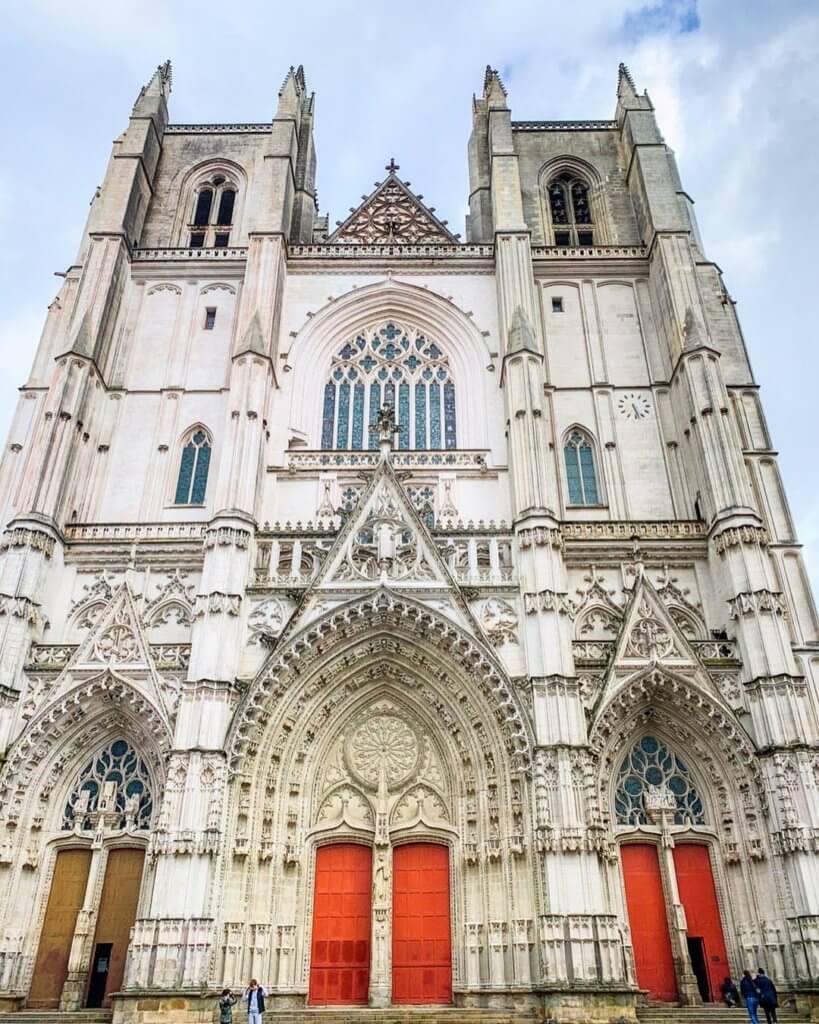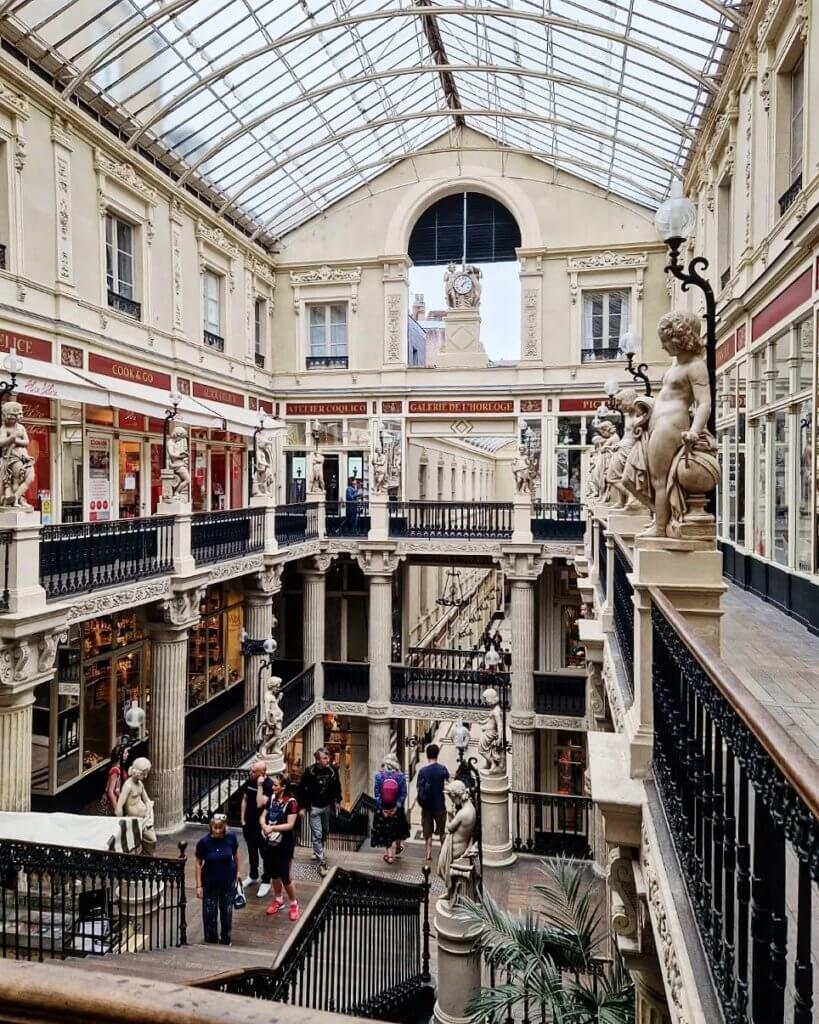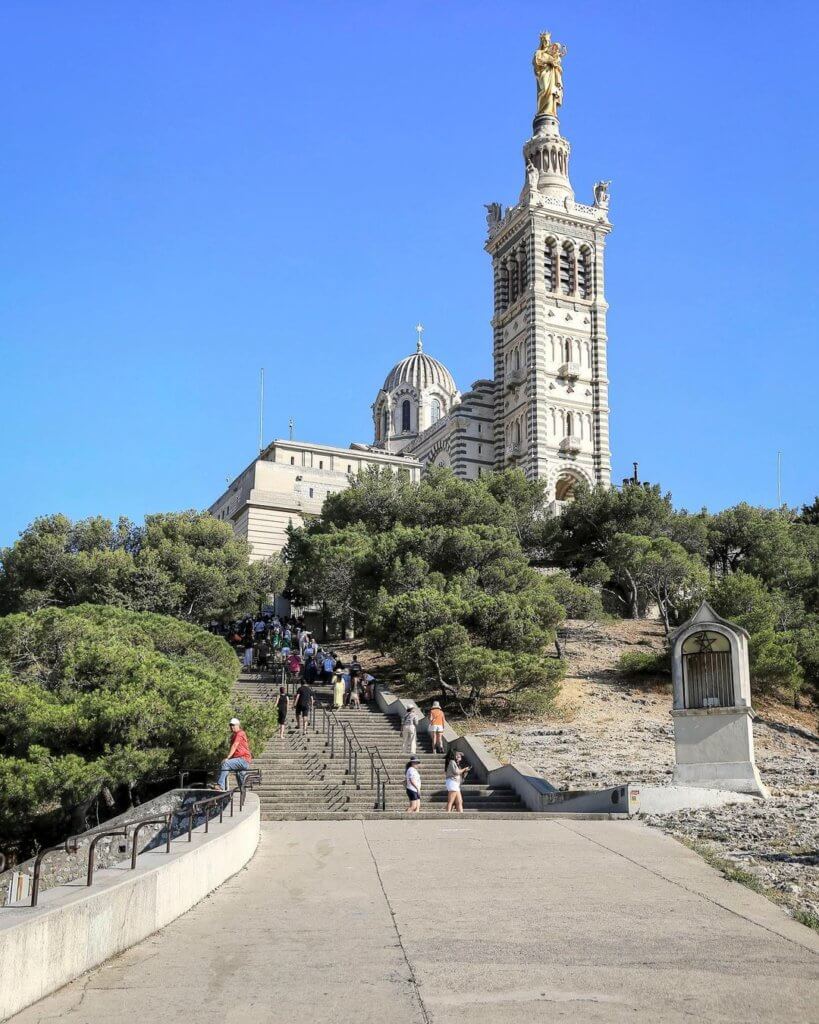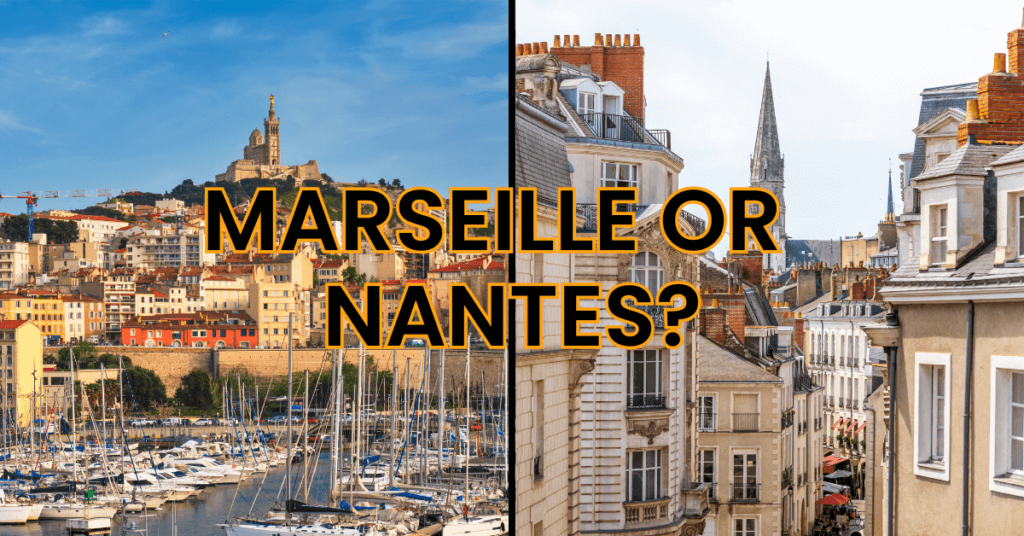Marseille or Nantes? Which city should you visit?
Can’t decide between Marseille or Nantes for your next French adventure? This guide’s got you covered. Here’s a quick lowdown on both cities:
🏛 History Buffs: Both of these cities have long and interesting histories. But Marseille takes the lead with the amount of historical attractions nearby like Abbey of Saint-Victor and Château d’If.
🏖 Beach Lovers: Unlike Nantes, Marseille is overlooking the sea and has plenty of beaches you can walk to from the city centre. Making Marseille the clear winner.
🥐 Foodies: Both of these cities are great for seafood, Marseille has more North African influences and its world famous bouillabaisse whilst Nantes is offers more traditional French cuisine. Which you’d prefer to visit depends on your palate.
🌳 Nature Enthusiasts: Marseilles Calanques National Park is hard to beach for anyone that loves the outdoors. Nantes is very close to a couple of nature reserves but they can’t beat the jaw dropping scenery of the Calanques National Park.
🏢 Urban Explorers: Nantes has a beautiful city centre, pretty parks and a diverse art scene. Marseille is a great city to explore but if you’re looking for somewhere interesting and unspoilt by international tourism Nantes is your best bet.
🍷 Wine Lovers: Whilst Marseille may be situated in the middle of Provence, most of the vineyards aren’t particularly close. Whereas Nantes has plenty of vineyards to visit just south of the city.
🎒 Backpackers: Nantes’ lower cost of living and unique art scene make it an amazing destination for backpackers. Marseille can be a bit pricier and more touristy.
👵 Over 60’s: Nantes’ easy-to-navigate city centre, inner city gardens and flat terrain make it perfect for the older generation. Marseille is hilly and can get extremely busy, especially in summer.
👨👩👦 Family-Friendly: Nantes is an excellent choice for families, offering a variety of child-friendly museums, parks, and even a mechanical elephant you can ride at Les Machines de l’île. Marseille has its share of family activities, like days at the beach and boat trips, but can get very crowded. Nantes wins for family-friendly options.
If you’re looking for an ancient city, incredible natural beauty and a seafood-rich culinary scene, Marseille is for you. On the other hand, if you’re looking for somewhere more budget-friendly with a vibrant art scene, amazing local vineyards and plenty to do for the kids, Nantes should make your list.
If you still can’t decide keep reading to find out more about both cities.
Marseille
Marseille might not boast the romantic allure of Paris or the glamour of the French Riviera, but its unique charm is undeniable. Perched on the Mediterranean coast, Marseille is a melting pot of cultures, an attribute reflected in its vibrant streets and diverse cuisine. With a history dating back to ancient Greece, it’s a paradise for those who love delving into the past.
Its old port, Vieux Port, bustles with fish markets and boats, while the iconic Notre Dame de la Garde basilica watches over the city from a hilltop. But there’s more to Marseille than just history and picturesque views. It’s also a city of dynamic cultural life, with a myriad of museums, art galleries, and music festivals. If you’re in search of a city that combines rich heritage, gastronomic delights, and a laid-back seaside atmosphere, Marseille is the place to be.

Nantes
Nantes, often touted as the most liveable city in Europe, is a delightful fusion of history and innovation, seamlessly intertwining its rich heritage with a progressive mindset. This Atlantic Coast city, once the capital of Brittany, has a vibrant culture marked by the stunning Château des ducs de Bretagne, the whimsical Machines de l’Île, and the lush Jardin des Plantes.
Its dynamic art scene is alive not just in the many museums, but also on the streets with an array of public art. Nantes is also a city of festivals, with music, film, and art celebrations occurring throughout the year. Add to this a blossoming food scene with a fondness for local produce and seafood, and it’s clear why Nantes is a hidden gem just waiting to be discovered.

Cathédrale Saint-Pierre-et-Saint-Paul de Nantes – Photo by juliabocchese
While we’re comparing Marseille and Nantes in this post, we’ve also looked at how Marseille stacks up against other cities like Cannes, Lille or Nice. We’ve linked to those articles below if you want to take a look!
Pros and Cons of Marseille and Nantes
Marseille Pros:
- 🏛 History: Oldest city in France, rich in historical landmarks.
- 🏖 Beaches: Direct access to Mediterranean beaches.
- 🍴 Cuisine: Famous for seafood and North African influences.
- 🌳 Nature: Calanques National Park for outdoor lovers.
- 🍷 Wine: Close to Provence’s wine regions.
Marseille Cons:
- 💶 Cost: Can be expensive, especially for tourists.
- 👫 Crowds: Can get busy, especially during peak seasons.
- 🌄 Terrain: Hilly, might be tough for some to navigate.
Nantes Pros:
- 🎨 Art: Diverse art scene and installations around the city.
- 🍷 Wine: Plenty of vineyards just south of the city.
- 💵 Budget: Generally cheaper than Marseille.
- 🌳 Nature: Close to several nature reserves.
- 👵 Accessibility: Easier to navigate, flat terrain.
Nantes Cons:
- 🏖 No Beach: Not a coastal city, so no beaches.
- 🥐 Cuisine: More traditional French, less variety than Marseille.
- 🏛 Fewer Historical Sites: Less historical depth compared to Marseille.
How long to stay in Marseille
Deciding on the ideal length for your Marseille visit can be a bit complex, given the rich cultural, historical, and natural attractions the city offers. The city has an abundance of experiences that can keep you engaged for days on end, but how long to stay will largely depend on your personal interests.
If your primary goal is to experience the unique Mediterranean vibe of the city, sample local seafood, and explore the historic district, a 2 to 3-day visit might suffice. This should give you ample time to wander through the narrow streets of Le Panier, the city’s old town, take a leisurely walk around the Vieux Port, and indulge in authentic bouillabaisse at a seaside restaurant.
For travellers drawn to Marseille’s rich history and culture, a stay of 4-5 days would be ideal. This gives you enough time to visit the iconic Basilique Notre-Dame de la Garde, explore the Museum of European and Mediterranean Civilisations (MUCEM), and take a ferry to the historic Château d’If, without feeling rushed.

However, if you’re like me and prefer a deeper immersion into the local culture, you might want to consider staying longer. A week in Marseille would provide ample time to not only explore the city’s attractions, but also to enjoy its beautiful beaches, take day trips to the nearby Calanques National Park or the charming town of Cassis, and truly soak up the laid-back Marseille lifestyle.”
How long to stay in Nantes
Deciding how long to stay in Nantes can be a tough call, given the city’s rich history, captivating art scene, and vibrant culture. The duration of your stay primarily depends on your personal interests and how leisurely you wish to explore.
If your goal is to soak up the city’s lively vibe, stroll through the historic city centre, and sample some local gastronomy, a stay of 2 to 3 days should be enough. This gives you sufficient time to wander through the cobbled streets of the Bouffay district, take a relaxing walk along the Erdre River, and indulge in regional cuisine at a traditional French restaurant.
However, if you wish to delve deeper into Nantes’ cultural heritage and history, consider extending your visit to 4 to 5 days. This will allow ample time to discover historical sites like the Château des ducs de Bretagne, appreciate modern art installations of the Voyage à Nantes, and visit the Machines of the Isle of Nantes without feeling pressed for time.

For those seeking a more immersive experience, spending a week in Nantes can be an excellent choice. This period will not only provide time to thoroughly explore the city’s attractions but also leave room for relaxing moments in the beautiful Jardin des Plantes, embarking on day trips to nearby gems like the charming vineyards of the Loire Valley, and truly immersing yourself in the vibrant lifestyle of Nantes.
How much is food and drink in Marseille and Nantes?
| Item | Marseille (€) | Nantes (€) |
|---|---|---|
| Beer | €5 – €8 | €5 – €8 |
| Glass of wine | €4 – €10 | €4 – €10 |
| Coffee | €2 – €4 | €2 – €4 |
| Meal at a midrange restaurant | €20 – €40 | €20 – €40 |
The prices are estimated averages and could vary depending on the place and the quality of the items.
How much is it to stay in Marseille or Nantes?
| Accommodation Type | Marseille Average Prices (per night) | Nantes Average Prices (per night) |
|---|---|---|
| Luxury Hotel | €150 – €500 or higher | €150 – €400 or higher |
| Midrange Hotel | €80 – €150 | €70 – €150 |
| Budget Hotel | €40 – €80 | €40 – €70 |
| Hostel | €20 – €40 | €20 – €40 |
Please note that these are estimated average prices and may vary based on the specific location and time of year.
When is the best time to visit Marseille?
🌼 Spring: From April to June, the weather in Marseille is comfortably warm, with temperatures averaging between 15-23°C (59-73°F). The city isn’t too crowded, and the beautiful Calanques (rocky inlets) are perfect for hiking and picnicking.
☀️ Summer: July and August are the hottest months, with temperatures reaching 30°C (86°F). It’s a great time for beach activities, water sports, and enjoying the vibrant nightlife. However, it’s also peak tourist season, so it can get crowded, and prices for accommodation can be higher.
🍂 Autumn: September to October is another lovely period to visit. The weather remains warm but becomes more comfortable. It’s an ideal time to explore the city and its surrounding countryside without the summer crowds. Also, the sea is still warm enough for swimming.
❄️ Winter: From November to March, Marseille experiences mild winters compared to other parts of France. While it isn’t beach weather, it’s a good time to explore the city’s museums and historical landmarks. There are fewer tourists, and you might find some great deals on accommodation.
However, always remember to check the local weather forecast before your trip, as weather conditions can change unexpectedly.
When is the best time to visit Nantes?
🌼 Spring: In Nantes, the months of April to June bring mild and comfortable weather, with temperatures ranging from 12-20°C (54-68°F). The city starts to burst into colour with blossoming flowers, making it a lovely time to explore parks like the Jardin des Plantes. Various outdoor events and festivals start taking place, adding a vibrant touch to your visit.
☀️ Summer: From July to August, temperatures can reach up to 25°C (77°F), offering perfect weather for enjoying the city’s outdoor attractions like the Île de Versailles. Do note, however, that these are the peak tourist months, so expect a bit more crowd and possibly higher prices.
🍂 Autumn: The months of September and October see temperatures around 15-20°C (59-68°F). The city is less crowded during this period, and the fall foliage in parks and along the riverbanks provides a beautiful backdrop for leisurely walks and bike rides.
❄️ Winter: From November to March, temperatures in Nantes can drop to around 5-10°C (41-50°F). While it’s not the ideal time for outdoor activities, it’s a good opportunity to explore Nantes’ museums, like the Château des Ducs de Bretagne, and enjoy indoor events and concerts.
Regardless of when you plan to visit, it’s always a good idea to check the weather forecast closer to your travel dates as conditions can sometimes change.
Average Monthly Temperatures
| Month | Marseille (High / Low °C) | Marseille Rain (days) | Nantes (High / Low °C) | Nantes Rain (days) |
|---|---|---|---|---|
| January | 12° / 5° | 6 days | 9° / 3° | 12 days |
| February | 13° / 6° | 4 days | 10° / 3° | 10 days |
| March | 16° / 8° | 4 days | 13° / 4° | 9 days |
| April | 18° / 9° | 5 days | 16° / 6° | 8 days |
| May | 23° / 13° | 4 days | 19° / 9° | 9 days |
| June | 26° / 17° | 2 days | 23° / 12° | 7 days |
| July | 29° / 19° | 1 day | 25° / 14° | 6 days |
| August | 29° / 19° | 2 days | 25° / 14° | 6 days |
| September | 26° / 16° | 3 days | 22° / 12° | 7 days |
| October | 21° / 13° | 6 days | 17° / 9° | 10 days |
| November | 16° / 9° | 5 days | 13° / 5° | 11 days |
| December | 13° / 6° | 5 days | 10° / 3° | 12 days |
Getting around Marseille:
Marseille has a good public transportation system, including buses, trams, and a metro system. Taxis are also available but can be expensive. Walking is a great way to explore the city centre, but if you want to cover more ground, consider renting a bike or taking a boat tour. The Marseille city pass is worth getting if you’re planning on using public transport.
Getting around Nantes:
Nantes boasts an efficient and user-friendly public transportation system, which includes trams, buses, and a bike-sharing scheme called Bicloo. The tram network in Nantes is one of the most extensive in France, with three lines covering many key attractions in the city. Your tram ticket will also allow you to hop on and off buses within a set period, typically an hour, which makes getting around the city a breeze.
For those who prefer a more active mode of transport, the Bicloo bike-sharing scheme offers an excellent option. Nantes is known for being a bicycle-friendly city with numerous dedicated cycle lanes and routes, making it easy and safe to navigate.
Walking is another great way to explore Nantes, especially in the compact city centre where many of the key sites are located. Plus, you’ll get to enjoy the city’s beautiful architecture and vibrant street life up close.
Taxis and Ubers are readily available in Nantes. However, be aware that in the pedestrianized zones of the city centre, you may need to walk a short distance to catch a ride.
Top things to do in Marseille
- Old Port (Vieux Port): This bustling harbour is the heart of Marseille. It’s lined with cafes and restaurants, and it’s the perfect place to enjoy a bouillabaisse, the traditional Provençal fish stew. Don’t miss the fish market that takes place every morning at the port.
- Le Panier: Just north of the Old Port is Marseille’s old town, Le Panier. Wander through its narrow, winding streets to discover charming squares, art galleries, boutiques, and cafes.
- Notre-Dame de la Garde: This iconic basilica sits on the city’s highest point and offers panoramic views of Marseille. Its interior is equally stunning with beautiful mosaics.
- The Calanques: These rocky inlets with crystal clear waters are perfect for hiking, swimming, and boating. They can be found along the coastline between Marseille and Cassis.
- MuCEM (Museum of European and Mediterranean Civilisations): This museum is notable not only for its comprehensive exhibits but also for its stunning architecture and sea views.

Top things to do in Nantes
- Château des Ducs de Bretagne: A must-visit landmark in Nantes, this impressive castle is home to the Nantes History Museum. With its beautiful architecture and fascinating exhibits, it offers an insightful look into the city’s past.
- Les Machines de l’île: This unique artistic project is one of the city’s major attractions. Here, you can see gigantic mechanical animals, including the famous Grand Elephant. It’s an unforgettable experience for both kids and adults.
- Passage Pommeraye: An architectural masterpiece, this three-level shopping arcade dating from the 19th century is a great place to shop or simply admire its artistic beauty.
- Jardin des Plantes: This stunning botanical garden is the perfect spot to enjoy a relaxing stroll. It’s home to a variety of exotic plants, beautiful greenhouses, and even a few art installations.
- The Island of Nantes: This creative district located on a former shipyard site is a hub of culture and innovation. It’s home to various creative projects and installations, making it a must-visit for any art and culture lover.

How to spend three days in Marseille
Day 1: Exploring the Heart of Marseille
Kick off your visit to Marseille by exploring the vibrant Vieux Port (Old Port). Watch fishermen selling their catch, enjoy a cup of coffee at one of the numerous waterside cafés, or simply admire the hundreds of moored yachts. Next, stroll to Le Panier, Marseille’s old town, with its charming cobbled streets, colourful houses, artisan shops, and inviting cafés. After lunch in one of the local bistros, take a ride on the tourist train or climb the hill to visit Notre-Dame de la Garde, the city’s iconic basilica, offering panoramic views of Marseille. End your day with a delicious seafood dinner back at the Vieux Port.

Day 2: Discovering Culture and History
Start your second day at the MuCEM (Museum of European and Mediterranean Civilisations), known for its exhibits as well as its stunning architecture. Then make your way to the Palais Longchamp, home to Marseille’s fine art museum and natural history museum, surrounded by a grand park. After lunch, consider visiting Château d’If, a former fortress and prison on a small island off Marseille’s coast, famously featured in Dumas’ ‘The Count of Monte Cristo.’ Wrap up the day with dinner at one of Marseille’s excellent restaurants, perhaps trying the city’s signature dish, bouillabaisse.
Day 3: Nature and Leisure
Devote your last day in Marseille to the Calanques National Park. Depending on your preference, you can hike, kayak, or take a boat tour to explore these stunning limestone cliffs and turquoise waters. Make sure to pack a picnic to enjoy by the sea. After returning to the city, enjoy a leisure stroll along La Corniche, a scenic seaside boulevard, or visit Prado Beach for a more relaxing time. End your trip with a farewell dinner, relishing the flavours of Provençal cuisine.
How to spend three days in Nantes
Day 1: Exploring the Heart of Nantes
Begin your Nantes adventure in the city centre. Visit the Château des Ducs de Bretagne, home to the Nantes History Museum. Enjoy exploring the medieval fortress and its surrounding gardens. Afterwards, head to the Gothic-style Nantes Cathedral nearby. For lunch, find a local restaurant to sample some regional cuisine.
In the afternoon, enjoy a leisurely stroll along the scenic Loire River. Then, head to the Passage Pommeraye, an elegant shopping arcade from the 19th century. Round off your day with a delicious dinner at one of the city’s gourmet restaurants.
Day 2: Delving into Art and Innovation
Start your second day at Les Machines de l’île, a unique attraction inspired by the works of Jules Verne. Here, you can ride the gigantic Grand Elephant or the Marine Worlds Carousel. Post lunch, explore the creative district on the Island of Nantes, which is home to various artistic projects and installations.
In the evening, take a walk around the Trentemoult district, a former fishing village known for its colourful houses. Enjoy dinner at a riverside restaurant with views of the Loire River.

Day 3: Enjoying Nature and Leisure
Dedicate your last day to Nantes’ beautiful green spaces. Begin with a visit to the Jardin des Plantes, a stunning botanical garden. After a picnic lunch in the park, take a short boat ride to the quaint village of Trentemoult.
In the afternoon, explore the unique vineyards of the Nantes Wine Region or consider a short trip to the Atlantic coast, just a stone’s throw away from the city. End your trip with a farewell dinner in Nantes, reminiscing over your favourite moments from the trip.
Gareth is an avid city adventurer with a particular passion for finding amazing food! There’s quite literally nothing he doesn’t like. He spends most of his travelling time trying to find great restaurants and cafes to eat at. Alongside trying local street food which he loves! He’s done most of his travelling in Europe so far but would love to visit Japan and Mexico
When not travelling you can find Gareth boxing, running, or in the gym. He’s got a passion for exercise and loves physical challenges.
You can contact him at gareth@thecityadventurers.com

